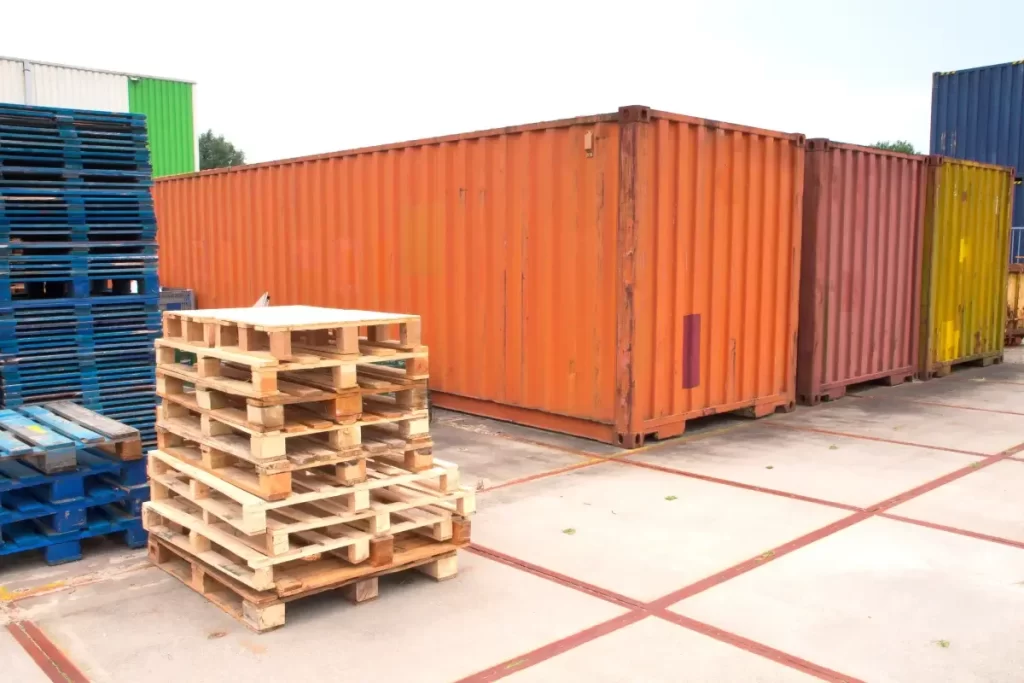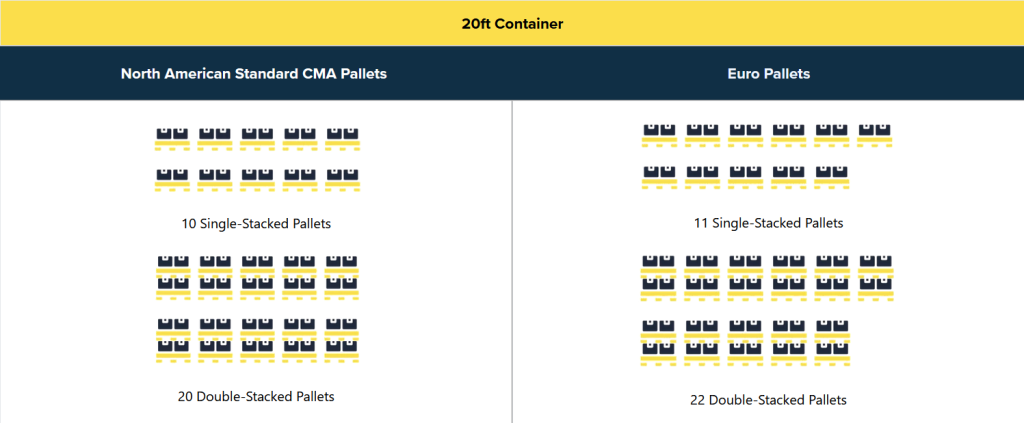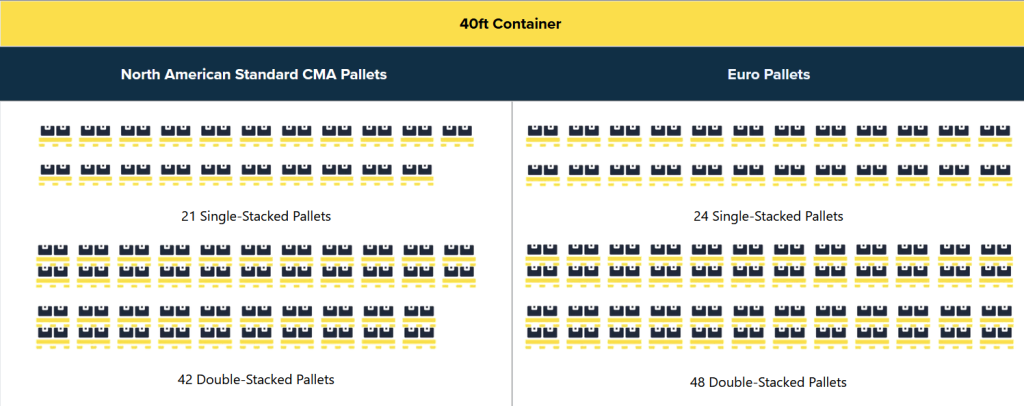How Many Pallets Fit in 20ft & 40ft Shipping Containers
Learn how many pallets fit in 20ft & 40ft shipping containers. Maximize
your cargo space with precise pallet arrangements for efficient
transport solutions.

When shipping or storing goods for logistics companies, warehouses, or retailers, every square inch of a shipping container counts. Failing to maximize the square footage of a container means that you might have to use more conexes than you actually need—driving up costs and risking transportation efficiencies. So, calculating how many pallets fit in a shipping container is an important equation that’s on every procurement professional and logistics manager’s mind.
If you want to know how many pallets fit in a 20ft or 40ft container—the two most common types of shipping containers used by exporters worldwide–the short answer is…it depends. Generally, a 20ft container can fit 11 Euro pallets or 10 standard pallets, while a 40ft container fits 24 Euro pallets or 21 standard pallets. However, factors like cargo height and weight, shipping requirements, and space for securing and handling are just a few considerations that impact pallet capacity. All of which we’ll dive deeper into in this article, ensuring you are equipped to properly calculate how many pallets you need to fit in your shipping containers.
Shipping Container Pallet Sizes and Types
To avoid wasting precious floor space in your containers, selecting the right pallet is key. The two most common pallet types are the Euro pallet and the standard pallet. Both of these pallet types are optimized to be transported by forklifts, pallet jacks, or conveyors. They both support the easy stacking and storing of products in shipping containers, warehouses, or trucks.
The Euro pallet is the most common type of pallet used when shipping and storing goods. According to the European Pallet Association, there are more than 650 million of these types of pallets circling around the globe. With dimensions of 800 x 1,200 mm (31.50 x 47.24 in), Euro pallets are built to fit through a standard exterior door, and have a safe working load of 1,500 kg (3,307 lbs).
The less common pallet size for containers, ironically, is the standard pallet. These pallets are 1,200 x 1,000 mm (47.24 x 39.37 in). They can carry a safe working load of 1,250 kg (2,756 lbs), and a maximum additional load of 4,250 kg (9,370 lbs) when stacking, making them a great option for heavy industrial loads.
Besides the Euro and standard pallets, which are used primarily for international shipping, there are other types of pallets optimized for alternative use cases. For instance, the North American pallet is sanctioned by the Grocery Manufacturers Association and is used widely in—you guessed it—North America. These pallets are 40 x 48 in and are commonly used in trucks to transport grocery items.
2. Calculating Shipping Container Pallet Capacity
The International Organization for Standardization (ISO) specifies the minimum or maximum values for dimensions of shipping containers, meaning you can reliably assume that your pallet layout will remain consistent across shipping containers of the same size. For more information on ISO-standardized sizes and measurements, check out our shipping container dimension guide.
How many pallets fit in a 20ft container?
20ft shipping containers are specifically designed to transport small volumes of heavy cargo, like farming and construction machinery. Their internal dimensions are 19’4”L x 7’8”W x 7’10”H, and their internal volume is 1,172ft3, which means they can generally fit 11 Euro pallets or 10 standard pallets when single-stacked. However, if the cargo weight and height enables double-stacking, the pallet capacity is doubled to allow 22 Euro pallets or 20 standard pallets.

How many pallets fit in a 40ft container?
40ft shipping containers are perfect for transporting large quantities of lightweight goods, like cotton, electronics, and furniture. Since their internal dimensions are 39’4”L x 7’8”W x 7’10”H, and their internal volume is 2,385ft3, 40ft containers have the capacity for 24 Euro pallets or 21 standard pallets when single-stacked. If the cargo weight and height allows for double-stacking, a 40ft container can theoretically fit up to 48 Euro pallets or 42 standard pallets.

Pallet Capacity Considerations
As we’ve mentioned, there are several factors that could inhibit a shipping container’s pallet capacity, such as:
1. Load height and weight limits. A 20ft standard container has a loading capacity of 62,016 lbs and a height of 7’10”. A standard 40ft container has a loading capacity of 63,383 lbs and 7’10”. Individual Euro palettes have a safe working load of 3,307 lbs each, and standard pallets have a safe working load of 2,756 lbs each before stacking. All of these height and weight considerations must be taken into account when calculating pallet capacity in a shipping container.
2. Cargo overhang. All cargo must fit within the surface area of a pallet. Any overhang could compromise pallet capacity.
3. Space for securing and handling. If the cargo requires any additional space for securing and handling, this could also impact pallet capacity.
4. Stacking cargo properly. If the products on pallets are not stacked properly, this could impact the pallet layout in a shipping container.
Picking Your Pallets
When considering what type of pallets to use, keep these checkboxes in mind:
1. Pallet loading height and weight. The loading height and weight of the products you’re shipping will determine whether a Euro or standard pallet will best fit your needs.
2. Shipping requirements. If you are transporting cargo internationally, pallets must comply with phyto-sanitary standards. This includes bearing the internationally recognized mark for heat treated export pallets.
3. Material. Although wood is the most common material used for storage and shipping given its durability and cost, some use cases could call for pressed wood, styrofoam, or plastic pallets.
Tips to Optimize Your Container Space
Here are a few quick-fire tips to help maximize the internal volume of your shipping containers with pallets.
1. Create tiers to maximize the height of your containers, loading heavier products on the bottom and lighter products on top.
2. Use cling wrap to secure your shipment and prevent damage.
3. Don’t let cargo stick out beyond the pallet.
On any given day, millions of pallets circle the globe by road, air, and sea, their surface area and loading weight carefully calculated by logistics experts who know that every square inch of a shipping container counts.
Now that you have a better understanding of how many pallets fit in 20ft and 40ft shipping containers, your next step is to find a container partner that can work alongside you to help meet all of your transportation and logistics needs. Calebwedman is here to help.
Calebwedman is the largest online marketplace in the U.S. for new and used shipping containers. Get a quote from us today.
